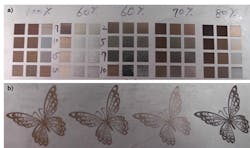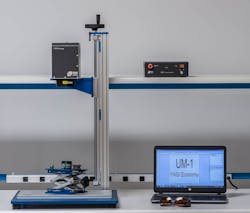Diode-pumped Solid-state Lasers: All-in-one DPSS lasers are tailored for marking and engraving
MARIN ILIEV and HEIDI GARDINER
Aided by advances in semiconductor technology and crystallography, diode-pumped solid-state (DPSS) laser systems have become the norm when it comes to fast and ultrafast (nano- to picosecond) high-power, industrial-grade laser systems. Currently, the most widespread amplification materials in these systems are Nd:YAG and vanadate (Nd:YVO4) because of their high gain, large thermal-load capabilities, and their close-to-single-frequency emission spectra.
These four-level systems are usually in an end-pumped rod or disk configuration to ensure close-to-perfect mode overlap with the pump beam, which in turn improves extraction efficiency of the energy deposited in the crystal by the resonating beam. The pump diode's narrow spectrum is sharply tuned to the 808 nm absorption line of neodymium, thus reducing the thermal load on the crystal.
The light output of diode arrays has an elliptical cross-section, making it hard to manipulate. Directly coupling the light into an optical fiber easily relays the pump light to the gain crystal while cleaning up the beam shape from the array, allowing for stacking of multiple diode emitters for higher pump power. The output end of the fiber is usually placed close to the gain crystal, separated only by the high-reflector mirror and two re-imaging lenses from the fiber tip to the crystal plane. This fiber coupling not only improves beam delivery, but it reduces the heat-extraction constraints of the design as well, as it separates the bigger portion of the heat generation (the laser diode) from the resonator. To manage some of the inherent consequences of a high-numerical-aperture (NA) fiber output, the beam is rescaled using lenses to give it a softer, smoother beam waist at the gain crystal.
Different types of marking
For marking and industrial applications, the most important laser characteristics are pulse energy, repetition rate, and a clean transverse laser mode. The main goal for such a laser is to be capable of fast marking over various material surfaces. We distinguish several marking types, such as deep engraving, dark annealing, and color annealing on specific surfaces.
In the nanosecond-pulse-duration regime, where Nd:YAG and Nd:YVO4 are used, very precise beam properties are required to allow switching between these modes of marking. Usually, a perfect Gaussian beam is desired for deep engraving. This is because a Gaussian mode is a free-space mode that propagates without change in the general profile, but rather a scaling in the peak power because of (de)focusing of the actual beam. A Gaussian beam can reach a peak power well above ionization levels in its most-intense regions and create a microscopic plasma that can remove a precise portion of the material that is being marked. The interaction with the plasma creates a circular imprint on the surface that has some depth. When the beam is scanned in a specific pattern, the connected dots produced by a number of pulses create the appearance of an engraved object.
Given a specific laser source, the tighter the beam can be focused, the smaller the individual dots will be, and the more dots will be needed to fill in the same-sized region. Smaller spots are ultimately limited in size by the beam quality and diffraction. A marker head using the same laser source quality—but at 532 nm—will mark with smaller spots than a 1064 nm system purely based on the diffraction limit.
Because of various effects in the resonator cavity, the output is usually not perfectly Gaussian in shape. This departure is expressed by the beam-quality (m2) value—in a typical RMI Laser system, this is on the order of 1.2 or better, where a value of 1 corresponds to a pure TEM00 Gaussian mode. It is important to notice that changing the pumping conditions in a resonator can affect the thermal gradient in the gain crystal, change the m2 value of the beam, and even break the mode structure. For some higher-power applications, an undoped cap made of the same crystal as the gain material is used to dissipate the heat and reduce the thermal lensing. This cap can be optically bonded or grown together to/with the regular gain portion of the crystal.
Pulse characteristics
The choice of pump-beam waist size can mean the difference between transverse single- and multimode operation. In many applications—such as marking and materials processing at nanosecond pulse durations—longitudinal modes are not controlled, as they do not play a large role in the process. However, longitudinal single-mode operation can be achieved by adding a bandpass filter based on a Fabry-Perot resonator that has a resonance spacing similar to that of the gain-bandwidth filtering of the integer multiples of the oscillating frequencies. A typical DPSS Nd:YVO4 laser with a 10–15 cm cavity (consisting of two mirrors parallel to each other), a gain crystal, and an acousto-optic modulator can produce pulses as short as 10 ns with energies of 0.5 mJ/pulse at 1064 nm. This output can be easily upconverted via second- or third-harmonic generation (SHG or THG) to get 532 or 355 nm outputs, respectively.
RMI Laser produces both 1064 nm and 532 nm systems in the multiwatt range. The shorter wavelengths are usually considered as "cold" marking and are suitable for glasses, plastics, and other similar materials that are easily cracked because of the temperature gradient associated with absorption that occurs while using a conventional 1064 nm beam. Shorter wavelengths also equate to smaller focal spot size and higher peak intensities at the marking plane, which in turn improves precision and marking quality.
A different type of laser marking in which the surface is not damaged by the laser light, but rather changes color because of oxidization, is called annealing. A typical dark annealing mark requires very precise focusing and energy conditions. A key role for this is the beam profile used. A top hat or almost square-in-profile beam will create an even intensity distribution and as a result evenly heat the area it hits. Oxygen from the air can then bind to the surface of the metal (typically steel) and change its color (see Fig. 1). This restructuring of the surface is nondestructive and is preferred when sterile environments are considered.
A slight variation to the process is color marking. Here, during the restructuring of the surface, bubbles are formed that, when solidified, reflect different wavelengths of the incident ambient light. We have found great success producing such marks with our in-house U-20 machine—generally, great stability and tunability are required to have a consistent result on a specific material.
All-in-one solves problems
While many DPSS lasers on the market aim for large pulse powers and have complex system designs, one of the approaches we took was to make a very stable, low-power (about 1 W Q-switched), portable tabletop device with OEM integration. The UM-1 laser marker (see Fig. 2) combines all components related to its operation in the marker head itself, which solves some longstanding issues of typical DPSS systems such as changes in laser output power caused by bending of the pump fiber and thermal stability of electronics and RF components, while providing portability because of its light weight (50 lbs., including the enclosure). The system is air-cooled and dust- and environment-resistant.System stability is enhanced via the use of so-called RF control mode, where to achieve a change in pulse power, the pump diode is left at a constant current and the losses in the cavity (via Q-switch modulation) are varied instead. As discussed, while changing the pump current, the thermal lens in the gain crystal can change dramatically. To provide the flexibility to change the pulse energy during marking, either there needs to be less energy in the crystal (lower pump current on the diode) or the losses in the cavity must be increased. The latter approach provides a much more stable cavity, as the geometric beam propagation stays almost constant during this modulation.
In the case of the UM-1 system, the cavity has a slightly curved optic on one side to compensate for the thermal lens induced by the pump beam and is most stable only when certain pump power levels are achieved. We leave the pump diode at this power level to lock the physical stability of the cavity. The Q-switch modulator is then varied accordingly to suppress lasing completely or to allow the highest possible pulse out of the resonator.
The cavity Q-switch driver has both a logical clock signal and an analog input to it. When the voltage on the analog line hits its maximum value, the cavity is suppressed from lasing by the Q-switch, but intermittent voltages result in tunable output power of the beam. This translates into versatile marking capabilities for the marker head. The all-in-one thermal packaging provides constant temperature to the Q-switch driver and thus minimizes the drift of suppressing power because of the change in electrical component resistivity with ambient temperature. In addition, the all-in-one approach minimizes sealing points and thus maintenance.
In the future, multiwatt laser marking systems will no doubt adopt the all-in-one design because of its stability, simplicity, and integration ability in industrial lines. However, smaller systems like the UM-1 will expand the market to kiosk-based applications and small-business store integration, allowing laser marking to escape the industrial environment and reach the everyday user much like conventional printing technology has in the past.
Marin Iliev is laser R&D manager with a PhD in applied physics from the Colorado School of Mines and Heidi Gardiner is marketing coordinator, both at RMI Laser, Lafayette, CO; e-mail: [email protected]; www.rmilaser.com.

